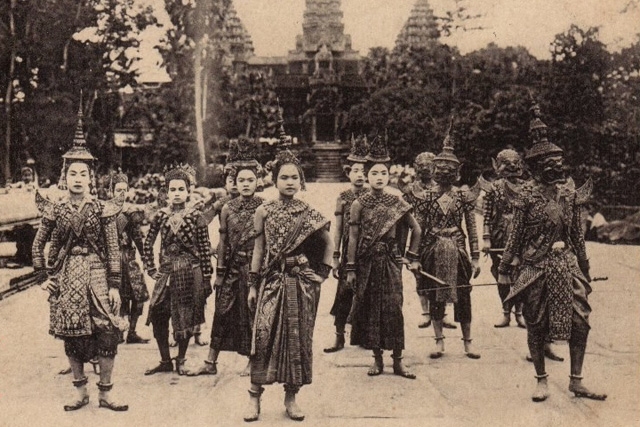Dance and Drama on Cambodian Temples

by Boreth Ly
Images of dance and drama are found both on bas reliefs and in free
standing sculpture from ancient Cambodian temples. Unfortunately, we
know very little about the meanings and gestures of dance in ancient
Cambodia. While a Sanskrit dance treatise, the Natyasastra, sheds light
on ancient dance in India, no such text has survived in Cambodia.
Moreover, ancient inscriptions written in both Sanskrit and Khmer
(Cambodian language) on stone stele reveal little about the nuances of
ancient dance and drama. We do, however, know that dance, drama, and
music were performed as ritual offerings to the gods and ancestors. A
7th-century Sanskrit inscription mentions the donation of dancers as
part of a ritual and material offering to a temple. Another inscription
dating from the 9th century tells us that King Yashovarman I (889-ca.
900 AD) learned music and dance. We also know that King Jayavarman VII
(1181- ca.1218 AD) donated thousands of dancers to the temples of Preah
Khan and Ta Prohm. Not surprisingly, there are many images of elegant
dancers found at Preah Khan. In addition, a segment of a long stone
relief from the Bayon, an early 13th-century temple, provides a glimpse
of this same act of ritual offering. We see here a group of patrons,
devotees, and flying celestial dancers paying homage to a four-armed
Vishnu. (See "Vishnu at Bayon.")
The scarcity of written sources makes it very difficult to establish a
historical link between ancient and contemporary dance. While the
legacy of dance was transmitted orally and bodily, what the classical
Cambodian Court Dancers perform today is often a modern reinvention. A
case in point is the Apsara dance (Robam Apsara) included in the
current tour. This particular dance was created in the late 1950s by
Queen Kossamak based on the story of the “Churning of Ocean of Milk”
(see image) depicted on the bas reliefs of the 12th-century temple of
Angkor Wat.
Taken from the Bhagavata Purana, the “Churning of the Ocean of Milk”
was favored by ancient Khmer kings and their artists. It tells the
story of the gods and demons who fought in vain to extract the nectar
of immortality from the ocean of milk. Eventually they turned to Lord
Vishnu for help. Vishnu, using Mt. Mandara as a churning stick led the
gods and demons in a collaborative effort to produce the amvrita
(nectar). In addition to the nectar, many other treasures emerged ;
including the apsaras (Sanskrit = from the water but commonly referred
to as celestial dancers). The ornate costumes, crowns, and jewelry worn
by contemporary Cambodian dancers appear to be direct copies of those
of the dancers depicted on these bas reliefs. (See Apsarases images.)
The resemblance is so close that one can easily imagine that these
contemporary dancers emerged from the static stone reliefs to set the
world in motion. Not surprisingly, most of the movements in the apsara
dance (and other dances included in the current repertoire) mirror the
poses represented in ancient sculptures. It is possible that the
frontal focus, the contorted movement of bodies, and the flexible hand
gestures seen in contemporary Cambodian dance are derived from and
inspired by the different poses depicted on Angkorian stone reliefs.
Apsaras are an embodiment of the ideal female beauty in Cambodian
culture. Both modern and ancient Khmer artists rendered them
elaborately and with great emotional intensity. We find the most
charming and flirtatious apsaras at the early 13th-century temple of Ta
Som. One of them confidently shows off her ornate right earring. (see
image "Apsara showing off her right earring") while another two dancers
are depicted equally sensuously and self-absorbed; one holding lotus
flowers in her hands, and the other is caught in the act of squeezing
water from her long hair. (fig. 9)
The ancient pictorial narrative traditions and dancers depicted on
stone reliefs serve as a source of artistic inspiration and reinvention
for both modern Khmer dancers and puppeteers. Moreover, the significant
role of dance as ritual and material offerings to the gods continues to
be visible in contemporary Cambodia. We see dancers move elegantly as
they present offerings of incense, fruit and their dance to the
teachers and ancestors every Thursday at the Royal University of Fine
Arts in Phnom Penh. (fig. 11)